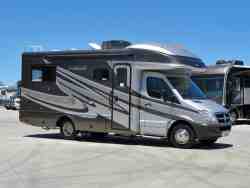Battery Care: How To Get The Most From Your Deep Cycle Battery
Regular battery care is the best way for you to get the most from your deep cycle battery. Whether you are using a traditional wet cell battery,
or a newer AGM battery
if you take the time to perform proper battery care, your house battery will live a long and productive life. If you don't, it will let you down, and will do so at the worst time… when you are supposed to be having fun!
Not Troubleshoot Your RV Batteries
When you are out using your Class C Motorhome, you do not want to constantly have to worry about whether or not your batteries are being drained too fast

As an aside, when I talk about battery care, I'm also wanting to include car battery maintenance along with the normal RV battery maintenance that is normally accomplished during the fall and spring months of the year.
With a little preparation, that focuses on RV battery maintenance, along with a good understanding of cause and effect, you should be able to relax, take a deep breath, and enjoy your outdoor activities.
Having a reliable Deep Cycle Battery is all about how well you perform your battery care. You do it right, and you will be rewarded with multiple amp-hours of recreation fun.
Preventive
battery care on a deep cycle battery
means you should test the voltage or electrolyte, check the individual cells' water level, and clean their terminals on a regular basis.
My personal opinion is that a Deep Cycle RV Batteries should never go below 12.06 V. DC (50%).
For a Twelve Volt Battery
Voltage______State of Charge
Some people say you can take the deep cycle RV batteries down to as little as 11.58 V. DC (20%), but if proper battery care is your concern, I don’t see that this is a good choice unless there is a very compelling reason to do so.
Just for the record, a full charge will show 12.6+ V. DC on your multimeter. However, you will have a temporary condition called a surface charge that will give you a false high voltage reading. This condition will occur just after completing a charge cycle.
To obtain a true voltage reading on your battery, you must let it rest for over 12 hours. You can also apply a 25 amp load for 3 or so minutes and then wait 3 to 5 minutes. This will knock the surface charge down and allow you to observe a true state of charge.
There are a few simple conservation techniques that can be easily applied to get the most amp-hours out of a standard wet-cell or AGM battery; and, therefore, help you get the most from your goal of efficient battery care.
and they will last a long time.
They also like to be charged just as slowly. This is one of the reasons that solar charging works so well in motorhomes.
Even healthy batteries stay happier when you treat them with respect and give them appropriate battery care. Knowing that these batteries like to share their current sparingly, it makes sense to use applications where a small current drain is the norm.
Energy Saving Accessories
After a while, this becomes a naturally occurring situation. You start this process of battery care when buying electronics or anything electrical in nature.
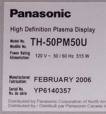
The trick is to look at the power requirements on the data plate. The data plate is usually located on the back or bottom of an appliance. When purchasing items for your Class C Motorhome, you want to make a habit of choosing items that use the smallest amount of watts.
For example, if you have a choice between buying a TV that draws 55 watts and one that draws 75 watts, with all other things being equal, get the one that uses 55 watts.
When you convert watts to amps (Amps = Watts / Volts), you will then know how many amps are leaving your battery each hour you use the TV.
It works like this... in all Class C Motorhomes, DC voltage is 12 volts. So, you would divide the 55 (watts) by 12. (55/12 = 4.58 amps). See, it’s not that hard. The 75 watt TV works out to 75/12= 6.25 amps. There would be 1.67 amp-hour difference.
This may not seem like a lot, but if you watched TV for 5 hours, you would use an extra 8.35 amps each day. In 5 days you would have used an extra 41.75 amp-hours.
I've found a ton of information in the book Managing 12 Volts
Extend Your Battery Life
Another area that has real potential for drawing a large amount of current over time is the lights. Most Class C Motorhomes come equipped with the 12V 15W incandescent bulb. You can easily have 10 or more of these things located throughout your Class C Motorhome. Using this type of bulb will make your battery care goal that much harder to achieve.
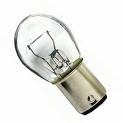
These lights are just one of many potential areas in a Class C Motorhome that can rob you of amp-hours. It should be noted here that the 12V incandescent bulb
may not be the best choice for lighting your rig.
It just depends on what you want to do and where you want to go. If you are in a situation where you have to get your 12V from a battery bank, well, you can expect that these incandescent bulbs will drain them fast!
Battery Overnight
There are other areas that will also drain your big deep cycle batteries. You may have mysterious voltages that are drawing down your batteries. They are called Phantom loads, and if you want to spend any quality time off the grid, you will want to get a handle on them. A Phantom load will overwork your battery because it will drain them when you think everything is turned off. You simply cannot achieve efficient battery care while you have these types of voltage issues.

Return To Top Of Page
Leave How To Conserve And Care For Your Deep Cycle Battery Page, And Return Aftermarket Class C Motorhome Accessories Can Improve
Your Rig's Performance! Page
Leave How To Conserve And Care For Your Deep Cycle Battery Page, And Return To Class C Motorhome Info Made Simple Homepage
Your Stories
Onan AC Generator Wouldn't Start
1995 Tioga Montara Had a Leak - Ouch!
A Simple Way To Put An Elecrtrical Thermostat On A Small Space Heater In A Truck Camper!
A Great Destinaton, With An Unexpected Outcome!
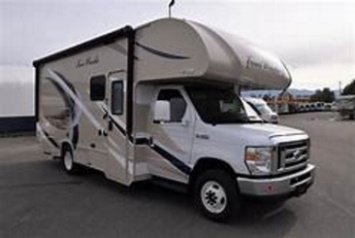
2018 Thor 21F Four Winds Class C Motorhome
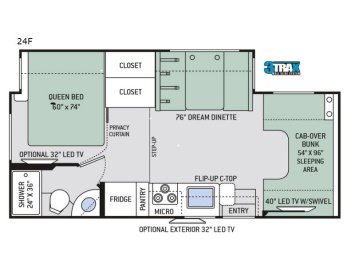
2018 Thor 21F Four Winds Class C Motorhome
2010 Fleetwood Pulse 24D
Class C Motorhome

2010 Fleetwood Pulse 24D
Class C Motorhome
Above Graphics Courtesy of:
http://www.DeMartini.com
| Gasoline Prices |






